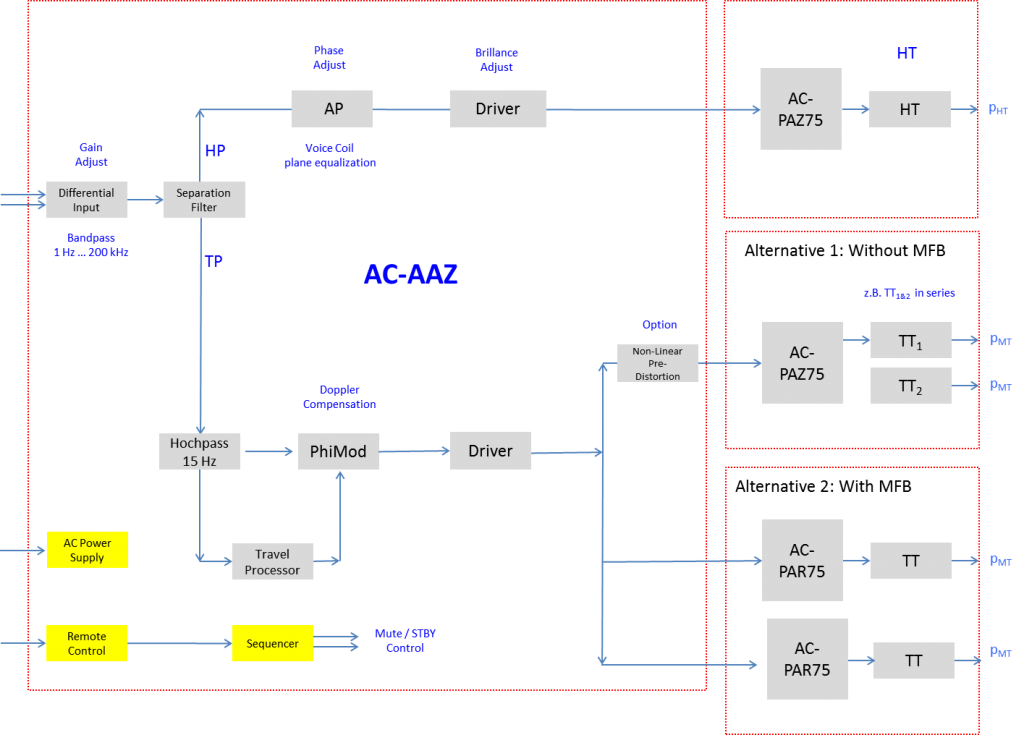Keith_W
Major Contributor
I haven't seen this discussed in ASR, nor am I aware of any speakers that use this technology.
ASR members might have heard of AudioChiemgau because they manufacture the Mode Compensator which allows two microphones to measure bass frequencies, removing the effect of the room - as discussed in this ASR thread.
They also manufacture these modules:
- AC-AAZ02 analog audio processor which needs to be placed upstream of their power amplifier module,
- AC-PAR75 power amplifier module with integrated motion feedback sensor module
The way the components are hooked up looks like this:

In use, a sensor is placed on the voice coil of the speaker and connected to the Motion Feedback (MFB) sensor. In their words:
They also claim:
As mentioned, I am not aware of any speaker that uses this technology. It would seem as if this could be retrofitted to many suitable drivers, the only caveat is that you would have to make the amplifier yourself using their modules.
It seems as if the main benefit would be to reduce nonlinearities, improve LF extension, and provide Doppler compensation.
When I read all this I thought it sounded marvellous but then my immediate question was - where is the evidence? That website has a nice description of how the technology works, along with some data sheets, but I do not see any measurements proving that the intervention works. Nevertheless, it does sound very exciting. In fact, any new technology that improves loudspeaker performance is exciting for me.
My questions to ASR:
- are you aware of anybody using this technology at all? Any measurements?
- what do you think of the claims of the manufacturer?
- anybody keen on purchasing some modules to test?
ASR members might have heard of AudioChiemgau because they manufacture the Mode Compensator which allows two microphones to measure bass frequencies, removing the effect of the room - as discussed in this ASR thread.
They also manufacture these modules:
- AC-AAZ02 analog audio processor which needs to be placed upstream of their power amplifier module,
- AC-PAR75 power amplifier module with integrated motion feedback sensor module
The way the components are hooked up looks like this:

In use, a sensor is placed on the voice coil of the speaker and connected to the Motion Feedback (MFB) sensor. In their words:
An analog processer generates a signal representing continuously the speaker membrane position. This signal controls a phase modulator which exactly equalizes the phase modulation caused by the variable membrane position. The AC-AAZ generates in other words a virtually steady speaker membrane – or more accurately described, the acoustic phase center is kept at a fixed location.
They also claim:
A sensor measures the travel, velocity or acceleration of the speaker membrane and a closed control loop ensures, that any deviation from the ideal value is immediately corrected. In an ideal case – and we at AudioChiemgau can approximate that ideal case extremely well – only the non-linearity of the sensor and its frequency response determine the overall characteristics of the MFB speaker. Especially the advances in the MEMS-technology allow now to build nearly perfect speakers. The amplifier module AC-PAR75 uses that new technology. The measured acceleration signal of the speaker membrane is compared with the audio input signal and closely controlled. This innovative technology allows on one hand to extend the SPL frequency response of a speaker far below its original resonance frequency (16 Hz are achievable even for small speakers) and on the other hand, it drastically reduces the non-linearity of the speaker (harmonic distortions between 0.1 and 0.03 % for the third order component are achievable). Even small high-end speakers with very low corner frequency become such feasible. Our AudioChiemgau caveat: The MFB control loop would keep the SPL constant even at very low and at infra-sound frequencies.
As mentioned, I am not aware of any speaker that uses this technology. It would seem as if this could be retrofitted to many suitable drivers, the only caveat is that you would have to make the amplifier yourself using their modules.
It seems as if the main benefit would be to reduce nonlinearities, improve LF extension, and provide Doppler compensation.
When I read all this I thought it sounded marvellous but then my immediate question was - where is the evidence? That website has a nice description of how the technology works, along with some data sheets, but I do not see any measurements proving that the intervention works. Nevertheless, it does sound very exciting. In fact, any new technology that improves loudspeaker performance is exciting for me.
My questions to ASR:
- are you aware of anybody using this technology at all? Any measurements?
- what do you think of the claims of the manufacturer?
- anybody keen on purchasing some modules to test?

